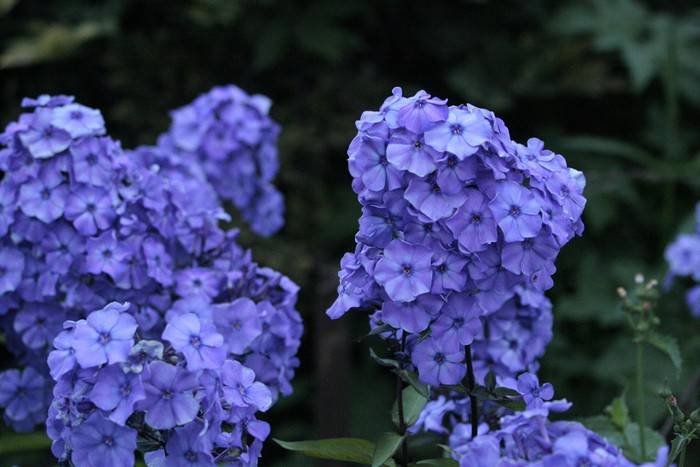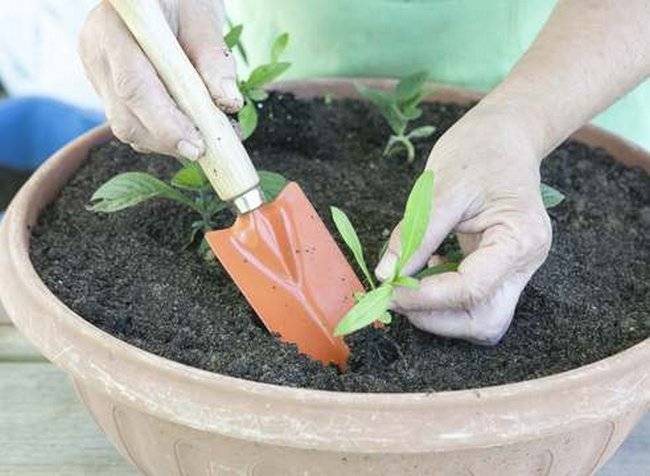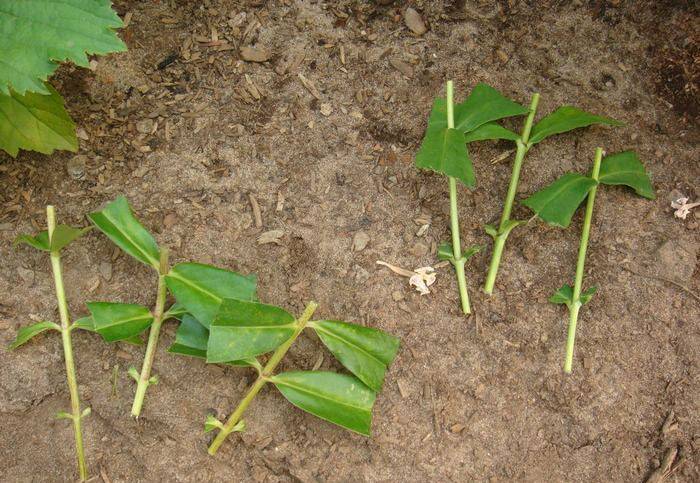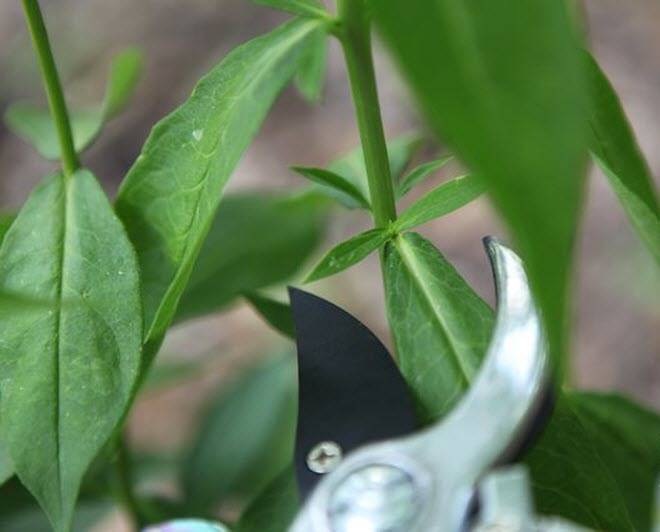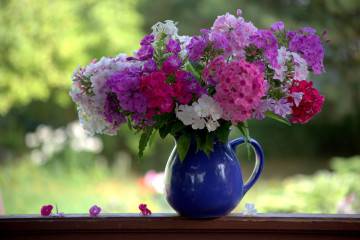Phlox Blue Paradise
Content:
Despite the fact that phlox is a fairly popular and unpretentious garden crop, the efficiency of its cultivation will directly depend on which variety is chosen for cultivation. One of the most spectacular outwardly and quite simple, from the point of view of cultivation, is the Blue Paradise paniculata phlox.
Description of the culture, history of the variety
Panicled phlox is a herb that belongs to the Sinyukhov family. Its natural habitat is in the southern United States, excluding Florida and the west coast. But after the plant gained popularity as a garden culture, it was cultivated in almost all countries of the world.
To date, there is no true history of the origin of the variety. It is only known that the flower was discovered in 1995 by accident.
Characteristics of phlox paniculata Blue Paradise
Despite the fact that it is a herbaceous plant, its height ranges from 70 cm to 1.2 meters. Sufficiently dense thick stems are formed, which form a compact bush of medium spreading.
Phlox has a fairly developed root system, but it is located mainly in the upper layers of the soil.
The plants are perennial - the upper part dies off at the end of the season, while the root system overwinters and gives new shoots in the spring.
Small flowers - from 2 to 4 cm, gather in inflorescences. The color can range from pale blue to blue - this color is shown by the phlox blue paradise. Although there may be other colors (except yellow).
A distinctive feature is resistance to some types of diseases, including fungi or powdery mildew.
Difficulties in the cultivation process have not been identified.
According to the description, the phlox Blue Boy is as similar to the Blue Paradise as possible.
How to preserve seedlings before planting in the ground
If phlox seedlings are available, but due to weather conditions they cannot be planted, then the open root system should be lowered into sphagnum moss, which should be slightly moistened beforehand. Place in a plastic bag and leave in a cool place. Periodically it is necessary to open the polyethylene in order to make sure that there are no putrefactive effects.
Features of planting varieties
Phlox Blue Paradise is not too picky about growing conditions, but it is still better to provide the plant with suitable conditions.
Finding a place for phlox
The most important thing is that the soil is fertile enough and does not contain excess moisture. It doesn't matter if the area is sunny or slightly shaded. Phlox Blue Paradise will handle both options fairly well. But the plant will not withstand intensely shaded areas - it will become too elongated, and the flowering period will be delayed. If possible, it is better to plant the plant on a small slope - this will allow water not to accumulate.
Soil preparation
It is best to choose a soil that has a neutral acidity index - no more than 7 units on the pH scale.
If you plan to plant phlox in the autumn, then the soil must be fertilized at least 2 weeks in advance. In the case of spring planting, you can prepare the soil in the fall.
It is necessary not only to clear the plane, but also to introduce the following components into the soil:
- peat;
- compost;
- lime;
- humus;
- wood ash;
- a small amount of suitable mineral fertilizers, depending on whether the flowering period has come or not;
- river sand.
It is also necessary to dig up the soil onto the bayonet of the shovel - so the structure becomes homogeneous and the lumps become smaller.
During digging, it is necessary to remove all foreign elements, as well as old rhizomes and weeds. If this manipulation is not done, then soon the sprouted plants will drown out the phlox.
If the soil is too dense and heavy, then sand or peat must be added to it. They will make the structure looser.
Planting phlox
When planting by sowing seeds, you need to start the process in mid-March. As soon as the seedlings have hardened enough, and two pairs of real leaves have appeared, it is necessary to make a pick. After that, it is necessary to protect the plants from direct sunlight.
When planting with cuttings, it is better to choose autumn. It is necessary to make planting holes at a distance of 0.5 m from each other. The cuttings are deepened by about 5 cm. Watering should be carried out only after 2-3 days from planting. The amount of water applied must be sufficient.
Watering
Phlox paniculata Blue Paradise is a fairly moisture-loving plant, most often it lacks moisture reserves in the soil. Therefore, it is necessary to ensure, especially in dry weather, a sufficient level of irrigation. Water is applied directly under the bush.
It is advisable that the water does not get on the flowers themselves, as well as the leaves. Since in this case their appearance may deteriorate.
If the plants are planted next to each other, then for every 1 m of such planting, approximately 17 liters of water must be applied. It is better to do this in the evening after the sun has set.
Top dressing
As in the case with other flowering plants, it is necessary to feed phlox, focusing on its growth stage:
- during a set of green mass, nitrogen components will have the most positive effect;
- when the budding process occurs, phosphorus and potassium will improve the process. You can also feed it with infused mullein during this period. If it is not possible to prepare it yourself, then you can purchase the appropriate fertilizer in a specialized store. Wood ash can be added to the mullein;
- then, in June, you can feed the phlox again. This time, focus on potassium. You can use urea, which must be added to the root;
- in the month of July, this type of feeding is repeated. To improve the effect, you can add a small amount of superphosphate;
- also after flowering is over, complex fertilizers are used as top dressing.
Pruning
The pruning procedure is carried out exclusively after the phlox has completely faded. But they do not perform it immediately, but gradually, over the course of about one month. Finish by the end of October.During this period, while the plant is gradually pruned, the root system accumulates the nutrients necessary in order to overwinter.
Spring pruning is also sometimes used. But it is carried out in warmer regions. This action is due to the fact that young shoots of phlox should not germinate too quickly.
Preparing phlox for winter
Pruning, which was described in the previous paragraph, is the main stage in preparing the plant for winter. But, in addition to her, you should pick up complex mineral fertilizers that will help accumulate strength for further growth in the next warm season.
After feeding and pruning have been carried out, the soil around the plants must be mulched with horse manure. If the winters are harsh, an insulating covering material is laid on top of it. Due to this, the snow will not melt and penetrate into the soil. And the root system will not freeze.
Disease protection
Blue Paradise variety, as well as phlox Magic Blue, varieties White Admiral, Windsor, Tim, as, in principle, and most paniculate species, are susceptible to attacks of diseases and parasites such as:
- phomos;
- powdery mildew;
- septoria;
- rust.
All of them are quickly eliminated by fungicides, which can be purchased in specialized stores.
But viral ailments can have an extremely negative effect on a garden plant. Various types of spotting, leaf necrosis or variegation are not affected by chemicals.
If one of the above viral diseases is found on phlox, then you will have to dig out the bush, grabbing as much soil as possible and destroy it. Do not leave under any circumstances, even outside your own fence. Since this can lead to an intensive spread of the disease.
If insects have settled on the plant, which suck the juices from the stems or gnaw the leaf plates, then they can be exposed to insecticides.
Another separate group is to highlight such pests as snails, caterpillars, other molluscs or insects. It is best to get rid of them by organizing collection and removal as far as possible outside the site.
If you take into account all the above recommendations, then it will be possible to grow a beautiful plant on the site, which will become a decoration of the garden.
